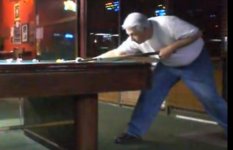GREAT conversation guys!...exactly what I was looking for. So, over the last couple of days I seat up my own experiment to attempt to justify using any one of the 3 ways I am gripping the cue. I'll call them "full" = fingers closed around the cue..."pinky" seemingly similar to full, but VERY different feeling with just the pinky off the cue....and "loose" holding the cue lightly removing as much tension as possible.
My test consisted of flipping coins to determine order, then playing a game of 3 cushion to 30 points after cleaning all the equipment and waiting a day between each test and all warm up using just that one "style".
Results...for reference those that don't follow 3c... an average of 1.0 is considered Pro speed by many.AND I'm a lefty.
>pinky... 30 points in 58 innings for a .517 average with a high run of 4. This is overall controllable with no surprises but lacks a bit of feel needed on very delicate shots. That, and I had a profound tip dip low right on shots hit hard I think from over use of the 3rd finger controlling the shot....
>full... 30 points in 63 innings at .476 average with a high run of 4. This way is I guess predictable, but lacks any dynamic feel or action on the CB. With the fingers out of play the wrist does all the work and if my timing was off the shots were worthless and felt dead.
loose>... 30 points in 42 innings for a .714 average with a high run of 6 and a 5 and 3 three times.....which will tell you I had a BUNCH of open innings or misses. Of course this is the best way for me and I do know it best, but my missed shots were from over rotating the CB or too much spin! This way is like having a gun in your hand but not really knowing what calibre round in the chamber....sometimes a .22 sometimes a 12guage

Controlling spin is key and moving closer to the center of the CB helped.
So, there it is, the average tells all and I think if I work on a way to control the whip in a loose grip it will work best.
have fun, G.
